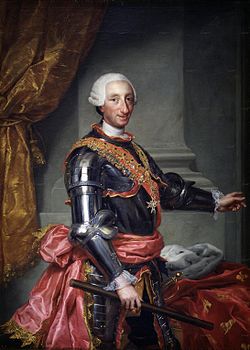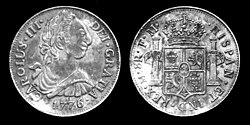Charles III of Spain: Difference between revisions
No edit summary |
mNo edit summary |
||
| Line 127: | Line 127: | ||
[[Category:House of Bourbon]] |
[[Category:House of Bourbon]] |
||
[[Category:Knights of the Golden Fleece]] |
[[Category:Knights of the Golden Fleece]] |
||
[[Category:Incumbents of the throne of the kingdom of Spain (Bourbon)]] |
|||
[[Category:Spanish generals|Charles of Bourbon]] |
[[Category:Spanish generals|Charles of Bourbon]] |
||
[[Category:1716 births]] |
[[Category:1716 births]] |
||
Revision as of 17:16, 8 June 2007
| Charles III of Spain | |
|---|---|
| Duke of Parma, King of Naples, King of Spain | |
 | |
| Reign | 1759-1788 |
| Predecessor | Ferdinand VI of Spain |
| Successor | Charles IV of Spain |
| Issue | Maria Louisa of Spain Charles IV of Spain Ferdinand I of the Two Sicilies |
| House | House of Bourbon |
| Father | Philip V of Spain |
| Mother | Elizabeth Farnese |
Charles III (January 20, 1716 – December 14, 1788) was King of Spain 1759–88 (as Carlos III de Borbón), King of Naples and Sicily 1735–59 (as Carlo VII), and Duke of Parma 1732–35 (as Carlo I). The first son of the second marriage of Philip V with Elizabeth Farnese of Parma, he was one of the so-called "enlightened monarchs".
King of Naples and Sicily
It was his good fortune to be sent to rule as Duke of Parma by right of his mother at the age of sixteen, and thus come under more enlightened influence than he could have found in Spain. On December 1, 1734 following Montemar's victory over the Austrians at Bitonto, he made himself master of Naples and Sicily by arms. Charles had, however, no military tastes, seldom wore uniforms, and could, only with difficulty, be persuaded to witness a review. The peremptory action of the British admiral commanding in the Mediterranean at the approach of the War of the Austrian Succession, who forced him to promise to observe neutrality under a threat to bombard Naples, made a deep impression on his mind. It gave him a feeling of hostility to the Kingdom of Great Britain which, in after-times, influenced his policy. In 1735, he resigned Parma to Emperor Charles VI in exchange for recognition as King of Naples and Sicily.
As King of Naples and Sicily, Charles began there the work of internal reform which he afterwards continued in Spain. Foreign ministers who dealt with him agreed that he had no great natural ability, but he was honestly desirous to do his duty as king, and he showed good judgment in his choice of ministers. The chief minister in Naples, Tanucci, had a considerable influence over him. It was during his rule that the Roman cities of Herculaneum (1738) and Pompeii (1748) were re-discovered. The king encouraged the excavations and was informed about the findings even after moving to Spain.
King of Spain
Template:House of Bourbon, 1700-1833
On August 10, 1759, his half-brother Ferdinand VI died and Charles succeeded him as King. On October 6, 1759 he abdicated the thrones of Naples and Sicily in favor of his third son, Ferdinand.
As king of Spain, his foreign policy was disastrous. His strong family feeling and his detestation of the Kingdom of Great Britain, which was unchecked after the death of his wife, Maria Amalia of Saxony, led him into the Family Compact with France. Spain was entangled in the close of the Seven Years' War, to her great loss. In 1770 he almost ran into another war over the barren Falkland Islands. In 1779 he was, somewhat reluctantly, led to join France and the American insurgents against England, though he well knew that the independence of the English colonies must have a ruinous influence on his own American dominions. For his army he did practically nothing, and for his fleet very little except build fine ships without taking measures to train officers and men.
But his internal government was, on the whole, beneficial to the country. He began by compelling the people of Madrid to give up emptying their slops out of the windows, and when they objected he said they were like children who cried when their faces were washed. In 1766, his attempt to force the madrileños to adopt the French dress for public security reasons was the excuse for a riot (Motín de Esquilache) during which he did not display much personal courage. For a long time after it he remained at Aranjuez, leaving the government in the hands of his minister Pedro Pablo Abarca de Bolea, Count of Aranda. Not all his reforms were of this formal kind.
Charles was a thorough despot of the benevolent order, and had been deeply offended by the real or suspected share of the Jesuits in the riot of 1766. He therefore consented to the expulsion of the order, and was then the main advocate for its suppression. His quarrel with the Jesuits, and the recollection of some disputes with the pope he had had when king of Naples turned him towards a general policy of restriction of the overgrown power of the church. The number of the idle clergy, and more particularly of the monastic orders, was reduced, and the Spanish Inquisition, though not abolished, was rendered torpid.

In the meantime, much antiquated legislation which tended to restrict trade and industry was abolished; roads, canals and drainage works were carried out. Many of his paternal ventures led to little more than waste of money, or the creation of hotbeds of jobbery. Yet on the whole the country prospered. The result was largely due to the king, who even when he was ill-advised did at least work steadily at his task of government. He created the Spanish Lottery and introduced Christmas cribs following Neapolitan models. During his reign, the movement to found "Economic Societies" (a rough prototype Chamber of Commerce) was born.
His example was not without effect on some at least of the nobles. In his domestic life King Charles was regular, and was a considerate master, though he had a somewhat caustic tongue and took a rather cynical view of mankind. He was passionately fond of hunting. During his later years he had some trouble with his eldest son and his daughter-in-law. If Charles had lived to see the beginning of the French Revolution he would probably have been frightened into reaction. As he died on the 14th of December 1788 he left the reputation of a philanthropic and philosophic king, still nicknamed "the mayor of Madrid" because of the public works there. In spite of his hostility to the Jesuits, his dislike of friars in general, and his jealousy of the Spanish Inquisition, he was a very sincere Roman Catholic, and showed much zeal in endeavouring to persuade the pope to proclaim the Immaculate Conception as a dogma necessary to salvation.
Ancestors
| Charles III of Spain | Father: Philip V of Spain |
Father's father: Louis, le Grand Dauphin |
Father's father's father: Louis XIV of France |
| Father's father's mother: Maria Theresa of Spain | |||
| Father's mother: Maria Anne of Bavaria |
Father's mother's father: Ferdinand Maria, Elector of Bavaria | ||
| Father's mother's mother: Adelaide Henriette of Savoy | |||
| Mother: Elisabeth Farnese of Parma |
Mother's father: Odoardo Farnese |
Mother's father's father: Ranuccio II Farnese, Duke of Parma | |
| Mother's father's mother: Isabella of Modena | |||
| Mother's mother: Dorothea Sophie of Neuburg |
Mother's mother's father: Philipp Wilhelm, Elector Palatine | ||
| Mother's mother's mother: Elisabeth Amalie Magdalene of Hesse-Darmstadt |
Marriage and children

Charles III married Maria Amalia of Saxony (1724-1760), daughter of Augustus III of Poland in 1738. They had 13 children; however, only seven reached adulthood:
- María Josefa (1744-1801)
- Maria Louisa (1745-1792). Married Leopold II, Holy Roman Emperor.
- Philip (Felipe) (1747-1777). Duke of Calabria but excluded from succession to the throne due to his imbecility.
- Charles IV (1748-1819), through whom the Spanish branch of Bourbons continues
- Ferdinand I of the Two Sicilies (1751-1825), founder of the Sicily branch of Bourbons
- Gabriel (1752-1788). Married Mariana Vitória Josefa of Portugal (daughter of Maria I of Portugal) and had issue.
- Anthony (Antonio) (1755-1817). Married his niece María Amalia, daughter of Charles IV. No issue.
See also
Selective bibliography
- Acton, Sir Harold (1956). The Bourbons of Naples, 1734-1825. London: Methuen.
- Lynch, John (1989). Bourbon Spain, 1700-1808. Oxford: Basil Blackwell. ISBN 0-631-14576-1.
- Petrie, Sir Charles (1971). King Charles III of Spain: An Enlightened Despot. London: Constable. ISBN 0-09-457270-4.
